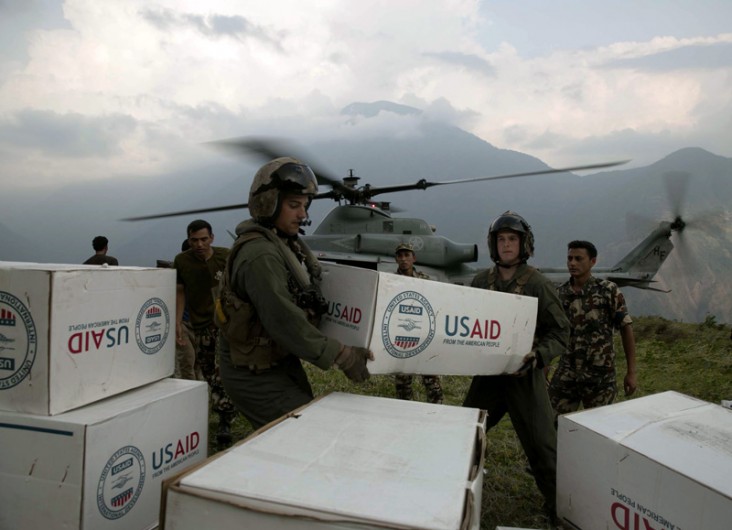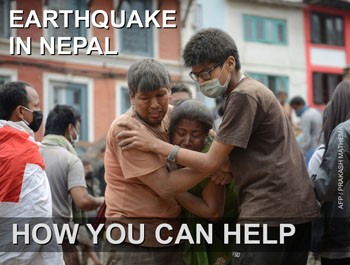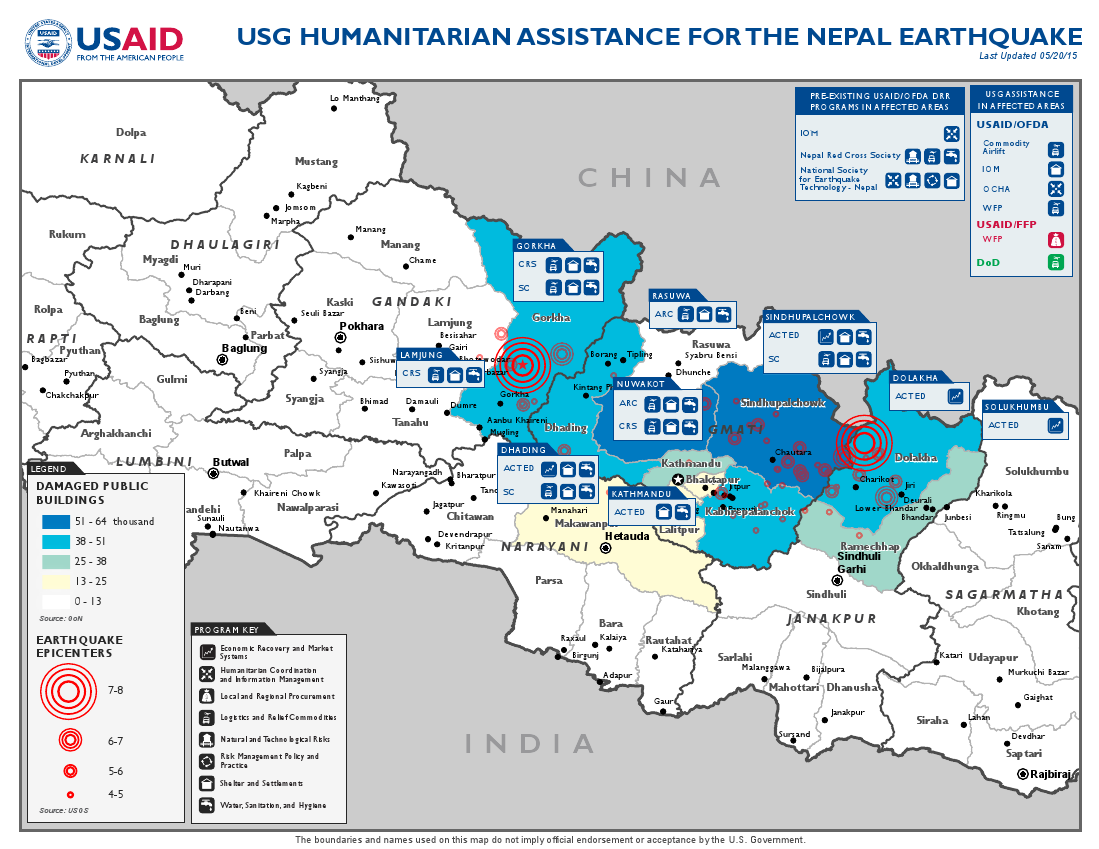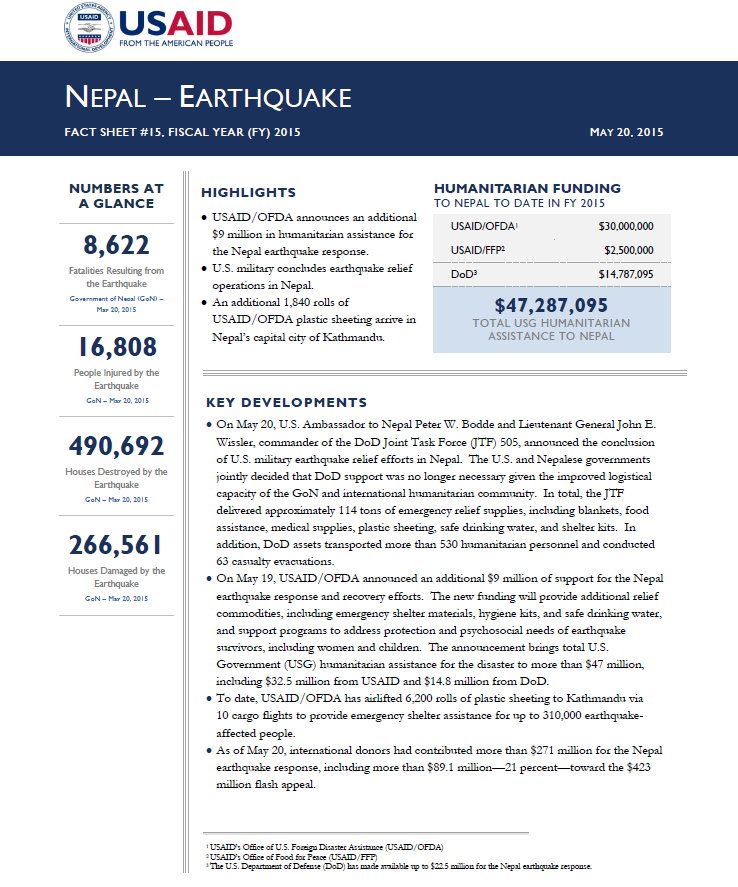Speeches Shim
May 20, 2015
Highlights
USAID/OFDA announces an additional $9 million in humanitarian assistance for the Nepal earthquake response.
U.S. military concludes earthquake relief operations in Nepal.
An additional 1,840 rolls of USAID/OFDA plastic sheeting arrive in Nepal’s capital city of Kathmandu.
Key Developments
On May 20, U.S. Ambassador to Nepal Peter W. Bodde and Lieutenant General John E. Wissler, commander of the DoD Joint Task Force (JTF) 505, announced the conclusion of U.S. military earthquake relief efforts in Nepal. The U.S. and Nepalese governments jointly decided that DoD support was no longer necessary given the improved logistical capacity of the GoN and international humanitarian community. In total, the JTF delivered approximately 114 tons of emergency relief supplies, including blankets, food assistance, medical supplies, plastic sheeting, safe drinking water, and shelter kits. In addition, DoD assets transported more than 530 humanitarian personnel and conducted 63 casualty evacuations.
Nepal Earthquake Map - May 20, 2015 ![]() (pdf - 962k)
(pdf - 962k)
Numbers At A Glance
8,622
16,808
490,692
266,561
Humanitarian Funding:
To Nepal To Date In FY2015:
| USAID/OFDA | $30,000,000 |
| USAID/FFP | $2,500,000 |
| DoD | $14,787,095 |
| TOTAL | $47,287,095 |
Nepal Earthquake Fact Sheet #15 - 05-20-2015 ![]() (pdf - 230k)
(pdf - 230k)
On May 19, USAID/OFDA announced an additional $9 million of support for the Nepal earthquake response and recovery efforts. The new funding will provide additional relief commodities, including emergency shelter materials, hygiene kits, and safe drinking water, and support programs to address protection and psychosocial needs of earthquake survivors, including women and children. The announcement brings total U.S. Government (USG) humanitarian assistance for the disaster to more than $47 million, including $32.5 million from USAID and $14.8 million from DoD.
To date, USAID/OFDA has airlifted 6,200 rolls of plastic sheeting to Kathmandu via 10 cargo flights to provide emergency shelter assistance for up to 310,000 earthquake-affected people.
As of May 20, international donors had contributed more than $271 million for the Nepal earthquake response, including more than $89.1 million—21 percent—toward the $423 million flash appeal.
HUMANITARIAN ASSESSMENTS AND LOGISTICS
On May 20, USAID/Nepal Mission Director Beth Dunford accompanied representatives from other international donors and the UN World Food Program (WFP) to a village in Tsum Valley in northern Gorkha District, which is currently only accessible via helicopter due to landslides. The village experienced extensive damage from the earthquake and aftershocks, with approximately 80 percent of households damaged or destroyed, according to the Mission Director. WFP distributed food and shelter materials during the visit to earthquake-affected populations in the area. The UN still has limited information on northern Gorkha, and UN Resident and Humanitarian Coordinator for Nepal Jamie McGoldrick (RC/HC) has urged relief agencies to continue assessing and addressing humanitarian needs in remote areas.
Following a recent trip to Gorkha and Sindhupalchowk districts, the RC/HC lauded the accomplishments of the UN clusters and partner organizations given the severity of damage and access obstacles in both locations. In Gorkha, the RC/HC reported that the UN clusters and partner NGOs are coordinating well with local GoN officials, who have expressed satisfaction with the current trajectory of relief operations. The RC/HC also reported that local officials in Gorkha are prioritizing the establishment of child-friendly spaces and provision of psychosocial support and shelter assistance for residents. In Sindhupalchowk’s Chautara Municipality, the Norwegian Red Cross Society has opened a field hospital, and USAID/OFDA partner the International Organization for Migration (IOM) has established a displacement site for earthquake-affected people. The UN Office for the Coordination of Humanitarian Affairs (OCHA) is coordinating humanitarian activities in the area.
The April 25 earthquake and ensuing aftershocks have affected approximately 5.6 million people, the RC/HC reported. The UN has used the level of housing destruction to identify populations in need; however, it is currently refining its definition and methodology as it identifies the number of people requiring reconstruction and recovery assistance. The RC/HC recently highlighted the danger of overlooking the current relief period of the earthquake response—expected to continue for at least four to six weeks—as urban search-and-rescue efforts have concluded and relief actors begin to commence reconstruction and recovery activities.
In conjunction with the conclusion of U.S. military operations, the UN Humanitarian Air Service (UNHAS) is providing three additional Mi8 helicopters to support humanitarian logistics operations in Nepal. With the new arrivals, the UNHAS fleet comprises five Mi8 helicopters for cargo transport and one AS-350 helicopter for assessments and evacuations.
SHELTER
The Shelter Cluster—the coordinating body for humanitarian shelter activities, comprising UN agencies, non-governmental organizations (NGOs), and other stakeholders—is seeking to improve response coordination by identifying NGOs to lead shelter activities in designated earthquake-affected districts. USAID/OFDA partners are the focal points for several affected districts, including Save the Children (SC) in Gorkha; IOM in Sindhupalchowk; and the Agency for Technical Cooperation and Development (ACTED) in Dhading. In addition, Plan International will serve as the focal point for Dolakha and Sindhuli districts, and GOAL will act as the focal point for Rasuwa District. The Shelter Cluster is currently determining leads for the remaining earthquake-affected districts.
On May 19 and 20, the final three shipments containing 1,840 rolls of USAID/OFDA-procured plastic sheeting arrived in Kathmandu. To date, USAID/OFDA has airlifted 6,200 rolls of plastic sheeting via 10 flights to provide emergency shelter assistance for up to 310,000 earthquake-affected people. USAID/OFDA has consigned the plastic sheeting to IOM for onward distribution through various partner agencies.

FOOD SECURITY
WFP reports an urgent need to provide earthquake-affected populations in mountainous regions with emergency food assistance prior to the onset of the June-to-August monsoon season, which will likely restrict humanitarian access to remote populations. During the week of May 18, approximately 20,000 porters began transporting WFP emergency food assistance to earthquake-affected populations in difficult-to-access villages.
As of May 18, WFP had distributed emergency food assistance to nearly 1.4 million people in seven of the most-affected districts—Dhading, Dolakha, Gorkha, Kabhre, Nuwakot, Rasuwa, and Sindhupalchowk. To date, USAID/FFP has provided WFP $2.5 million to support emergency food assistance for earthquake-affected populations.
HEALTH AND WASH
In recent days, health actors reported diarrhea cases in five of Nepal’s 14 most-affected districts, including Dolakha, Gorkha, Kavrepalanchok, Rasuwa, and Sindhupalchowk, according to the UN World Health Organization (WHO). Rapid assessment teams investigated reported cases, collected samples, and sent the samples for testing at the National Public Health Laboratory in Kathmandu; all samples tested negative for cholera, and health actors have implemented preventative cholera control measures in each district. WHO underscored the need to coordinate with GoN district health officers (DHOs) to monitor cholera rumors and plans to send rapid cholera test kits to the affected districts.
The Health Cluster has developed a contingency plan with the GoN Ministry of Health and Population (MOHP) to provide a framework for preparing and responding to diarrheal diseases. The Health Cluster plans to share the plan with DHOs in earthquake-affected districts, while health actors will provide additional support to ensure a coordinated, district-specific response. Additionally, WHO is decentralizing operations to emphasize district-level planning and responses. WHO district support officers are stationed in all 14 most-affected districts to support DHOs in coordinating response efforts and strengthening disease surveillance.
Earthquake-damaged infrastructure, a shortage of medical supplies, and increased demand for post-trauma and injury care have negatively affected the capacity of health facilities to deliver basic health care services in Nepal, according to WHO. A May 19 MOHP report indicates that the April 25 earthquake and ensuing aftershocks have damaged or destroyed approximately 1,100 health facilities.
While water, sanitation, and hygiene (WASH) assessments are ongoing at the village development committee level, the GoN Department of Water Supply and Sanitation (DWSS) has completed its WASH infrastructure damage assessment and determined a need for approximately $3.3 million to address earthquake-related damages. The DWSS is requesting $2.4 million for water treatment supplies, $685,000 for water system repair, $100,000 for data analysis and reporting, and $50,000 for water quality testing.
The UN Children’s Fund (UNICEF) is working with NGO Environment and Public Health Organization to scale up production of Piyush—a locally-produced chlorine product. Increased production will likely reduce needs for water treatment supplies, according to relief actors. To coordinate efforts, WASH organizations are sharing program locations and activities, such as distributing water purification supplies and encouraging boiling of water, with DWSS.
PROTECTION
The Protection Cluster is deploying additional staff to Nepal to increase protection response capacity. A UN protection advisor recently arrived to provide technical support for the RC/HC and relief actors. Additionally, an information management specialist is expected to arrive during the coming week.
On May 19, USAID Disaster Assistance Response Team (DART) and USAID/Nepal staff met with three NGO partners of The Asia Foundation at a shelter for young female survivors of human trafficking. USAID/Nepal supports The Asia Foundation to implement the ongoing Combating Trafficking in Persons project. Following the April 25 earthquake, the NGOs have worked alongside shelter and WASH organizations to ensure that affected households receive information regarding the risks of human trafficking. The NGOs also have placed mental health experts at health care centers to provide psychosocial support to affected populations and are training volunteers to help identify people who may need additional assistance. To prevent exploitation and provide targeted support, the NGOs are also gathering protection information on adolescent girls who lost family members during the earthquake. As the emergency response shifts to reconstruction and recovery activities, the NGOs plan to ensure that vulnerable and marginalized populations receive adequate assistance to renew livelihoods and establish economic security, further reducing the risk of exploitation and human trafficking.
CONTEXT
On April 25, a magnitude 7.8 earthquake struck central Nepal’s Gorkha District, approximately 77 kilometers (km) northwest of Kathmandu, at a depth of approximately 15 km, according to the U.S. Geological Survey (USGS).
The USG immediately issued a disaster declaration for Nepal due to the effects of the earthquake. Within hours of the seismic event, USAID/OFDA activated a Response Management Team (RMT) in Washington, D.C., and deployed a DART—including urban search-and-rescue specialists—to support emergency response efforts in Nepal.
On May 12, a magnitude 7.3 aftershock struck Nepal’s Dolakha District, approximately 76 km northeast of Kathmandu, according to USGS. The aftershock caused further casualties and damages in areas affected by the April 25 earthquake.
For nearly two decades, USAID/OFDA has supported disaster risk reduction (DRR) efforts in Nepal, including throughout Kathmandu Valley. USAID/OFDA funding has enabled partners to identify, prepare, and preserve more than 80 open spaces in Kathmandu Valley for humanitarian purposes; pre-position critical emergency relief supplies; and strengthen earthquake response capacity at the local and national levels in collaboration with the GoN, non-governmental organizations, private companies, and local communities. More information on USAID/OFDA’s DRR programs in Nepal and throughout South Asia is available at www.usaid.gov/what-we-do/working-crises-and-conflict/disaster-risk-reduc....
PUBLIC DONATION INFORMATION
The most effective way people can assist relief efforts is by making cash contributions to humanitarian organizations that are conducting relief operations. A list of humanitarian organizations that are accepting cash donations for disaster responses around the world can be found at www.interaction.org.
USAID encourages cash donations because they allow aid professionals to procure the exact items needed (often in the affected region); reduce the burden on scarce resources (such as transportation routes, staff time, and warehouse space); can be transferred very quickly and without transportation costs; support the economy of the disaster-stricken region; and ensure culturally, dietary, and environmentally appropriate assistance.
More information can be found at:
- The Center for International Disaster Information: www.cidi.org or +1.202.821.1999.
-
Information on relief activities of the humanitarian community can be found at www.reliefweb.int.




Comment
Make a general inquiry or suggest an improvement.